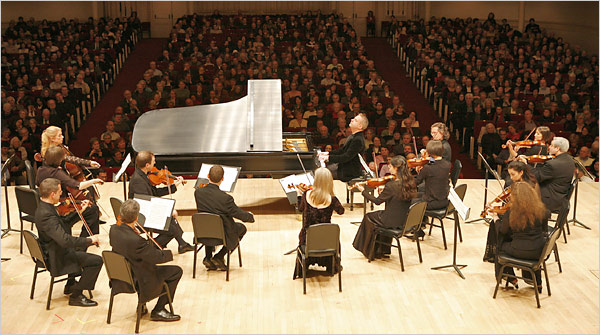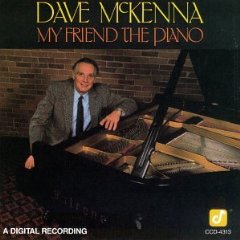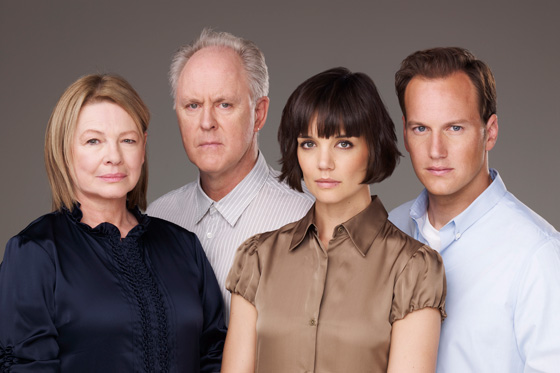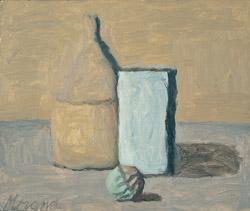 I’m up in Connecticut with Mrs. T, writing captions for the thirty-odd photographs that will be reproduced in A Cluster of Sunlight: The Life of Louis Armstrong, about which more later in the week. I was, alas, out of town when the Orpheus Chamber Orchestra gave the premiere of Paul Moravec‘s Brandenburg Gate at Carnegie Hall last Thursday night, but the composer was on hand to take a well-deserved bow. When not busy composing operas, Paul also writes instrumental music of tremendous distinction and individuality, and Brandenburg Gate, an homage to Bach’s Brandenburg Concerti, is one of his very best pieces. He called me in Connecticut on Friday morning to report that it was a hit, which didn’t surprise me in the least.
I’m up in Connecticut with Mrs. T, writing captions for the thirty-odd photographs that will be reproduced in A Cluster of Sunlight: The Life of Louis Armstrong, about which more later in the week. I was, alas, out of town when the Orpheus Chamber Orchestra gave the premiere of Paul Moravec‘s Brandenburg Gate at Carnegie Hall last Thursday night, but the composer was on hand to take a well-deserved bow. When not busy composing operas, Paul also writes instrumental music of tremendous distinction and individuality, and Brandenburg Gate, an homage to Bach’s Brandenburg Concerti, is one of his very best pieces. He called me in Connecticut on Friday morning to report that it was a hit, which didn’t surprise me in the least.
WNYC broadcast the concert live in New York and has since archived the program on its Web site. You can listen to it, as I did, by going here. The program also includes Haydn’s “Fire” Symphony, Jacques Ibert’s Hommage à Mozart, and the Saint-Saëns G Minor Piano Concerto, performed by Jean-Yves Thibaudet. To listen to Brandenburg Gate, skip forward to the thirty-minute mark in the playback. The performance is followed by an interview with Paul that was taped earlier in the day.
The announcers made public something that I’ve been keeping more or less under wraps until now, which is that Paul suffered a mild stroke in August. I’m sure I don’t need to tell you how scary that was, but the stroke, as you’ll hear when you listen to Paul talking about Brandenburg Gate, had no effect whatsoever on his mental processes (except that his e-mails were full of misspelled words for a week or so!). I’m delighted to say that he’s been spending the past few weeks orchestrating The Letter, which is, like A Cluster of Sunlight, moving steadily toward the finish line.
If you’d like to celebrate with us, check out Brandenburg Gate. I think you’ll like what you hear.
Archives for 2008
TT: Almanac
“Politics in a literary work is like a gun shot in the middle of a concert, something vulgar, and however, something which is impossible to ignore.”
Stendhal, The Charterhouse of Parma (trans. Jeri King)
TT: Neal Hefti and Dave McKenna, R.I.P.
Two more jazz masters have passed on. Neal Hefti was best known to the public for composing the Batman and Odd Couple themes, but among musicians it was his smoothly swinging work for Count Basie that made him legendary, in the process helping to update and redefine the language of postwar big-band arranging. The Atomic Mr. Basie, their best-known collaboration, contained “Li’l Darlin’,” the slower-than-slow ballad for which Hefti will always be remembered. Marc Myers’ obituary deftly summarizes his innumerable other musical achievements and offers a well-chosen list of recommended recordings. I especially like “The Good Earth,” the oft-reissued 1945 Woody Herman flagwaver that is one of my all-time favorite big-band recordings.
 Dave McKenna was best known for his unaccompanied piano solos, whose propulsive left-hand walking-bass lines rendered sidemen superfluous. He was also a consummately sensitive balladeer, and Solo Piano, recorded for Chiaroscuro in 1972, includes a version of Leonard Bernstein’s “Lucky to Be Me” that shows him at his most tender. (You can download it from iTunes.)
Dave McKenna was best known for his unaccompanied piano solos, whose propulsive left-hand walking-bass lines rendered sidemen superfluous. He was also a consummately sensitive balladeer, and Solo Piano, recorded for Chiaroscuro in 1972, includes a version of Leonard Bernstein’s “Lucky to Be Me” that shows him at his most tender. (You can download it from iTunes.)
McKenna recorded frequently before illness forced him into retirement, but not nearly enough of his albums remain in print. I hope Concord will hasten to reissue My Friend the Piano, for me his most satisfying record. Used copies are easy to find, and I suggest that you order one, listen to “Baby, Baby All the Time,” and mourn the passing of an artist.
* * *
“Li’l Darlin’,” “The Good Earth,” and “Lucky to Be Me” can all be downloaded from iTunes.
Hefti’s New York Times obituary is here. McKenna’s is here.
Doug Ramsey writes well about Hefti and McKenna here and here.
Here’s an appropriately elegiac McKenna medley of Leonard Bernstein’s “Some Other Time” and Johnny Mandel’s “A Time for Love”:
MUSEUM
Giorgio Morandi, 1890-1964 (Metropolitan Museum, 1000 Fifth Ave., up through Dec. 14). It’s too crowded, too noisy, and poorly hung, but the Met’s Morandi exhibition, the first ever to come to the United States, is still a major event, a retrospective of one hundred and ten paintings and works on paper by one of the greatest and least sufficiently appreciated still-life painters of the twentieth century. Unless you take the trouble to go to Bologna’s Museo Morandi, it’s unlikely that you’ll ever get another chance to see this many Morandis at one time, so pick an off hour, pack a set of earplugs, and dive in (TT).
TT: Don’t shoot the playwright
I review three shows in this week’s Wall Street Journal drama column. Two are on Broadway, All My Sons and To Be or Not to Be, and both are doubleplusungood. Not so the Cleveland Play House’s revival of Noises Off, which I liked enormously. Here’s an excerpt.
* * *
Everything that Arthur Miller was to become can be seen in embryo in “All My Sons,” his first hit, which ran for nine months on Broadway in 1947 and has now returned there in a revival graced–if that’s the word–by the presence of Katie Holmes. Earnest and hectoring, “All My Sons” is as much a secular sermon as a play, a school-of-Ibsen indictment of the moral emptiness of the American bourgeoisie, always a draw for guilt-wracked playgoers who enjoy being flagellated at $100 a pop. Unlike the plays that followed it, however, “All My Sons” is for the most part satisfyingly unpretentious, a next-to-no-nonsense wartime tragedy about a corrupt factory owner (John Lithgow) whose greed leads to the suicide of his soldier son, and it deserves better than this windy production, in which Simon McBurney commits first-degree directorial malpractice.
 Mr. McBurney is the artistic director of Complicité, a British avant-garde theater troupe whose work I admire. Perhaps not surprisingly, he has used “All My Sons” as a vehicle for his multi-media prestidigitation: Newsreel-style rear projections, thunderous sound effects and spooky incidental music are seen and heard throughout the evening, while Tom Pye’s minimalist set looks as though it were designed for an opera by Philip Glass. But while this trickery might well have been impressive if deployed in the service of one of Complicité’s surreal spectacles, it has nothing whatsoever to do with the modest exercise in kitchen-sink naturalism that is “All My Sons,” and Miller’s script all but disappears under the weight of Mr. McBurney’s staging….
Mr. McBurney is the artistic director of Complicité, a British avant-garde theater troupe whose work I admire. Perhaps not surprisingly, he has used “All My Sons” as a vehicle for his multi-media prestidigitation: Newsreel-style rear projections, thunderous sound effects and spooky incidental music are seen and heard throughout the evening, while Tom Pye’s minimalist set looks as though it were designed for an opera by Philip Glass. But while this trickery might well have been impressive if deployed in the service of one of Complicité’s surreal spectacles, it has nothing whatsoever to do with the modest exercise in kitchen-sink naturalism that is “All My Sons,” and Miller’s script all but disappears under the weight of Mr. McBurney’s staging….
Like most of the pretty young screen things who have made Broadway debuts in recent seasons, Ms. Holmes is a creature of the camera who doesn’t know the first thing about stage acting. Anyone misguided enough to make her professional stage debut on Broadway opposite Mr. Lithgow and Ms. Wiest in an Arthur Miller play is, of course, asking for trouble, and Ms. Holmes gets it in spades….
Ernst Lubitsch never made a funnier movie than “To Be or Not to Be,” in which Jack Benny played a second-rate Polish actor who bamboozles the Nazis in spite of himself. Why, then, attempt to turn so well-made a work of cinematic art into a stage play? A musical, maybe, but Nick Whitby’s adaptation, which takes the script of the 1942 film and pumps it full of new punch lines and a semi-serious ending, makes no sense at all–not least because none of Mr. Whitby’s jokes is even slightly funny….
“Noises Off,” first seen on Broadway in 1983, consists of a rehearsal and two performances of “Nothing On,” a not-so-hot British sex comedy acted by a calamity-prone touring troupe. The gimmick of the show is that the set is turned around for the second act, allowing us to witness the disastrous backstage occurrences from the actors’ point of view. The result is a metafarce–a farce whose subject matter is farce itself. Neeedless to say, so complicated a conceit cannot possibly be made to work without pristinely immaculate craftsmanship, but “Noises Off” fills the bill. Once the nine doors of James Leonard Joy’s two-story set start slamming, the laughter starts swelling in a crescendo so protracted that it’s a wonder people don’t faint in the aisles from sheer exhaustion.
David H. Bell, the director of this production, is a specialist in musical comedy who doubles as a choreographer, which may help to explain the miraculous exactitude with which he has staged “Noises Off.” Every comic bomb goes off at the right split-second….
* * *
Read the whole thing here.
Watch my wsj.com video review here:
TT: Almanac
“You critics are always writing about the meaning of music, the ethic, the Weltanschauung of the composer, and God knows what. The whole point of music is that it should sound well. Never mind what it signifies. Music should have wings and float and give delight.”
Sir Thomas Beecham (quoted in Neville Cardus, Autobiography
TT: So you want to see a show?
Here’s my list of recommended Broadway, off-Broadway, and out-of-town shows, updated weekly. In all cases, I gave these shows favorable reviews (if sometimes qualifiedly so) in The Wall Street Journal when they opened. For more information, click on the title.
Warning: Broadway shows marked with an asterisk were sold out, or nearly so, last week.
BROADWAY:
• Alfred Hitchcock’s The 39 Steps (comedy, G, suitable for bright children, reviewed here)
• August: Osage County (drama, R, adult subject matter, reviewed here)
• Avenue Q (musical, R, adult subject matter and one show-stopping scene of puppet-on-puppet sex, reviewed here)
• Boeing-Boeing (comedy, PG-13, cartoonishly sexy, reviewed here)
• Equus (drama, R, nudity and adult subject matter, closes Feb. 8, reviewed here)
• Gypsy (musical, PG-13, adult subject matter, reviewed here)
• The Little Mermaid * (musical, G, entirely suitable for children, reviewed here)
 • A Man for All Seasons (drama, G, too intellectually demanding for children of any age, extended through Dec. 14, reviewed here)
• A Man for All Seasons (drama, G, too intellectually demanding for children of any age, extended through Dec. 14, reviewed here)
• South Pacific * (musical, G/PG-13, some sexual content, brilliantly staged but unsuitable for viewers acutely allergic to preachiness, reviewed here)
OFF BROADWAY:
• The Fantasticks (musical, G, suitable for children capable of enjoying a love story, reviewed here)
CLOSING NEXT SATURDAY IN CHICAGO:
• R.U.R. (serious comedy, PG-13, adult themes, closes Oct. 25, reviewed here)
CLOSING NEXT SUNDAY OFF BROADWAY:
• Enter Laughing (musical, PG-13, full of sex jokes, closes Oct. 26, reviewed here)
TT: The second time around
 I heard from a connoisseur of the art of Giorgio Morandi not long after I posted yesterday morning on the deficiencies of the Metropolitan Museum’s Morandi retrospective:
I heard from a connoisseur of the art of Giorgio Morandi not long after I posted yesterday morning on the deficiencies of the Metropolitan Museum’s Morandi retrospective:
Another time we can perhaps discuss the Met’s presentation. It is a much neglected but in my eyes crucial element to understanding Morandi’s paintings, generally speaking and also to reveal their contemporaneity. To me they have specificity that requires very close attention to how they are (1) framed, (2) grouped, (3) spaced within a room. For example, no one would ever dare to jam as many Robert Rymans in one room, let alone that room. Giacometti is another you would not dare doing this to–although MoMA has (oops!).
The results, as you say, were “educational,” but only in the sense of being able to see the paintings in person rather than in reproduction. Had the Met mounted them with space to spare in the large galleries, it would have been a true eye opener towards greater understanding of the monumentality of Morandi’s work–and a riveting pleasure at that.
I couldn’t agree more. Morandi’s paintings should not be jammed together, as they are at the Met. They need plenty of space to breathe and resonate. They also need silence, and so I went back to the Met at noon yesterday to take a second look at the show, which I had seen under unfavorable circumstances on Sunday afternoon. It was slightly less crowded but no less full of enthusiastic conversationalists. Next time I’ll try going earlier in the morning.
When you go–and you should, soon–I commend your special attention to the following items: 4, 17, 34, 44, 57, 64, 82, 86 (from the Phillips Collection), 105, 107, 111, 120, 121, and 125 (Morandi’s last painting).
